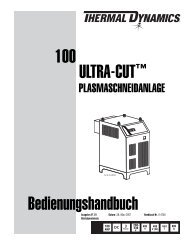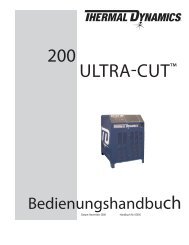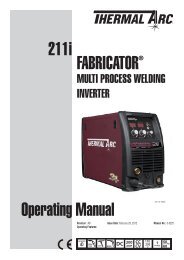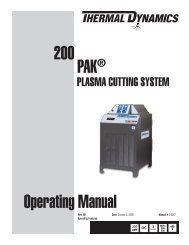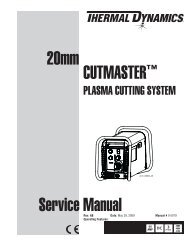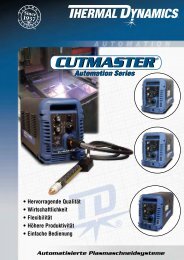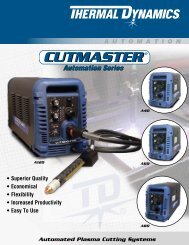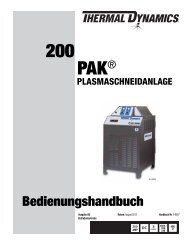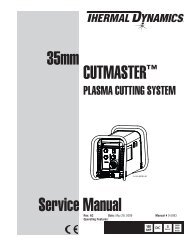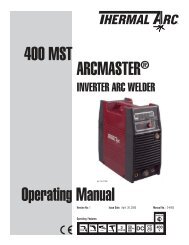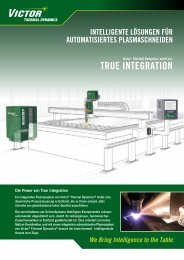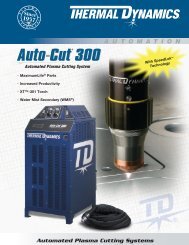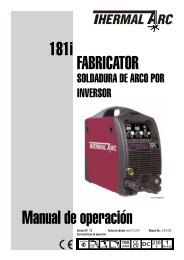Drag-Gun Plus Operating Manual - Victor Technologies - Europe
Drag-Gun Plus Operating Manual - Victor Technologies - Europe
Drag-Gun Plus Operating Manual - Victor Technologies - Europe
You also want an ePaper? Increase the reach of your titles
YUMPU automatically turns print PDFs into web optimized ePapers that Google loves.
Plasma Cutting System<br />
Model <strong>Drag</strong>-<strong>Gun</strong> <strong>Plus</strong><br />
With Built-In Air Compressor<br />
<strong>Operating</strong> <strong>Manual</strong><br />
December 13, 2005 <strong>Manual</strong> 0-4750
WARNINGS<br />
Read and understand this entire <strong>Manual</strong> and your employer’s safety practices before installing, operating,<br />
or servicing the equipment.<br />
While the information contained in this <strong>Manual</strong> represents the Manufacturer's best judgement, the<br />
Manufacturer assumes no liability for its use.<br />
Plasma Cutting Power Supply<br />
<strong>Drag</strong>-<strong>Gun</strong> <strong>Plus</strong><br />
PCH 42 Torch<br />
<strong>Operating</strong> <strong>Manual</strong> Number 0-4750<br />
Covered under U.S. Patents.<br />
Published by:<br />
Thermadyne Corporation<br />
82 Benning Street<br />
West Lebanon, New Hampshire, USA 03784<br />
(603) 298-5711<br />
www.thermal-dynamics.com<br />
©Copyright 2005 by<br />
Thermal Dynamics Corporation<br />
All rights reserved.<br />
Reproduction of this work, in whole or in part, without written permission of the publisher is prohibited.<br />
The publisher does not assume and hereby disclaims any liability to any party for any loss or damage<br />
caused by any error or omission in this <strong>Manual</strong>, whether such error results from negligence, accident, or<br />
any other cause.<br />
Printed in the United States of America<br />
Publication Date: December 13, 2005<br />
Record the following information for Warranty purposes:<br />
Where Purchased:____________________________________<br />
Purchase Date:_______________________________________<br />
Power Supply Serial #:________________________________<br />
Torch Serial #:________________________________________
TABLE OF CONTENTS<br />
SECTION 1:<br />
GENERAL INFORMATION ................................................................................................ 1-1<br />
1.01 Notes, Cautions and Warnings ...................................................................... 1-1<br />
1.02 Important Safety Precautions ....................................................................... 1-1<br />
1.03 Publications .................................................................................................. 1-2<br />
1.04 Declaration of Conformity ............................................................................. 1-4<br />
1.05 Statement of Warranty .................................................................................. 1-5<br />
SECTION 2:<br />
INTRODUCTION ............................................................................................................... 2-1<br />
2.01 INTRODUCTION .......................................................................................... 2-1<br />
2.02 GENERAL SPECIFICATION......................................................................... 2-1<br />
2.03 Features ....................................................................................................... 2-1<br />
2.04 Torch Specifications ..................................................................................... 2-2<br />
2.05 System Contents .......................................................................................... 2-2<br />
2.06 Transporting Methods ................................................................................... 2-2<br />
SECTION 3:<br />
INSTALLATION ................................................................................................................. 3-1<br />
3.01 Site Selection ............................................................................................... 3-1<br />
3.02 Electrical Input Connections ......................................................................... 3-1<br />
3.03 Torch ............................................................................................................ 3-1<br />
SECTION 4:<br />
OPERATION .................................................................................................................... 4-1<br />
4.01 Front Control Panel ....................................................................................... 4-1<br />
4.02 Preparations For <strong>Operating</strong> ........................................................................... 4-2<br />
SECTION 5:<br />
SERVICE .......................................................................................................................... 5-1<br />
5.01 Basic Troubleshooting Guide ......................................................................... 5-1<br />
Appendix 1: <strong>Operating</strong> Sequence, Block Diagram ..................................................................... 5-1<br />
Appendix 2: Torch Connection ................................................................................................... 5-2<br />
Appendix 3: System Schematic 230V Non CE .......................................................................... 5-3<br />
Appendix 4: System Schematic 230V CE ................................................................................. 5-4
SECTION 1:<br />
GENERAL INFORMATION<br />
1.01 Notes, Cautions and Warnings<br />
Throughout this manual, notes, cautions, and warnings<br />
are used to highlight important information. These highlights<br />
are categorized as follows:<br />
NOTE<br />
An operation, procedure, or background information<br />
which requires additional emphasis or is helpful<br />
in efficient operation of the system.<br />
CAUTION<br />
A procedure which, if not properly followed, may<br />
cause damage to the equipment.<br />
WARNING<br />
A procedure which, if not properly followed, may<br />
cause injury to the operator or others in the operating<br />
area.<br />
1.02 Important Safety Precautions<br />
WARNINGS<br />
OPERATION AND MAINTENANCE OF<br />
PLASMA ARC EQUIPMENT CAN BE DAN-<br />
GEROUS AND HAZARDOUS TO YOUR<br />
HEALTH.<br />
Plasma arc cutting produces intense electric and<br />
magnetic emissions that may interfere with the<br />
proper function of cardiac pacemakers, hearing aids,<br />
or other electronic health equipment. Persons who<br />
work near plasma arc cutting applications should<br />
consult their medical health professional and the<br />
manufacturer of the health equipment to determine<br />
whether a hazard exists.<br />
To prevent possible injury, read, understand and<br />
follow all warnings, safety precautions and instructions<br />
before using the equipment. Call 1-603-298-<br />
5711 or your local distributor if you have any questions.<br />
GASES AND FUMES<br />
Gases and fumes produced during the plasma cutting<br />
process can be dangerous and hazardous to your health.<br />
• Keep all fumes and gases from the breathing area.<br />
Keep your head out of the welding fume plume.<br />
Use an air-supplied respirator if ventilation is not<br />
adequate to remove all fumes and gases.<br />
The kinds of fumes and gases from the plasma arc<br />
depend on the kind of metal being used, coatings<br />
on the metal, and the different processes. You must<br />
be very careful when cutting or welding any metals<br />
which may contain one or more of the following:<br />
Antimony Chromium Mercury<br />
Arsenic Cobalt Nickel<br />
Barium Copper Selenium<br />
Beryllium Lead Silver<br />
Cadmium Manganese Vanadium<br />
Always read the Material Safety Data Sheets<br />
(MSDS) that should be supplied with the material<br />
you are using. These MSDSs will give you the information<br />
regarding the kind and amount of fumes<br />
and gases that may be dangerous to your health.<br />
For information on how to test for fumes and gases<br />
in your workplace, refer to item 1 in Subsection 1.03,<br />
Publications in this manual.<br />
Use special equipment, such as water or down draft<br />
cutting tables, to capture fumes and gases.<br />
Do not use the plasma torch in an area where combustible<br />
or explosive gases or materials are located.<br />
Phosgene, a toxic gas, is generated from the vapors<br />
of chlorinated solvents and cleansers. Remove all<br />
sources of these vapors.<br />
This product, when used for welding or cutting, produces<br />
fumes or gases which contain chemicals<br />
known to the State of California to cause birth defects<br />
and, in some cases, cancer. (California Health<br />
& Safety Code Sec. 25249.5 et seq.)<br />
ELECTRIC SHOCK<br />
Electric Shock can injure or kill. The plasma arc process<br />
uses and produces high voltage electrical energy. This<br />
electric energy can cause severe or fatal shock to the operator<br />
or others in the workplace.<br />
Never touch any parts that are electrically “live” or<br />
“hot.”<br />
December 13, 2005 1-1 GENERAL INFORMATION
Wear dry gloves and clothing. Insulate yourself<br />
from the work piece or other parts of the welding<br />
circuit.<br />
Repair or replace all worn or damaged parts.<br />
Extra care must be taken when the workplace is<br />
moist or damp.<br />
Install and maintain equipment according to NEC<br />
code, refer to item 9 in Subsection 1.03, Publications.<br />
Disconnect power source before performing any service<br />
or repairs.<br />
Read and follow all the instructions in the <strong>Operating</strong><br />
<strong>Manual</strong>.<br />
FIRE AND EXPLOSION<br />
Fire and explosion can be caused by hot slag, sparks, or<br />
the plasma arc.<br />
Be sure there is no combustible or flammable material<br />
in the workplace. Any material that cannot be<br />
removed must be protected.<br />
Ventilate all flammable or explosive vapors from<br />
the workplace.<br />
Do not cut or weld on containers that may have held<br />
combustibles.<br />
Provide a fire watch when working in an area where<br />
fire hazards may exist.<br />
Hydrogen gas may be formed and trapped under<br />
aluminum workpieces when they are cut underwater<br />
or while using a water table. DO NOT cut aluminum<br />
alloys underwater or on a water table unless<br />
the hydrogen gas can be eliminated or<br />
dissipated. Trapped hydrogen gas that is ignited<br />
will cause an explosion.<br />
NOISE<br />
Noise can cause permanent hearing loss. Plasma arc processes<br />
can cause noise levels to exceed safe limits. You<br />
must protect your ears from loud noise to prevent permanent<br />
loss of hearing.<br />
To protect your hearing from loud noise, wear protective<br />
ear plugs and/or ear muffs. Protect others<br />
in the workplace.<br />
Noise levels should be measured to be sure the decibels<br />
(sound) do not exceed safe levels.<br />
For information on how to test for noise, see item 1<br />
in Subsection 1.03, Publications, in this manual.<br />
PLASMA ARC RAYS<br />
Plasma Arc Rays can injure your eyes and burn your skin.<br />
The plasma arc process produces very bright ultra violet<br />
and infra red light. These arc rays will damage your eyes<br />
and burn your skin if you are not properly protected.<br />
To protect your eyes, always wear a welding helmet<br />
or shield. Also always wear safety glasses with<br />
side shields, goggles or other protective eye wear.<br />
Wear welding gloves and suitable clothing to protect<br />
your skin from the arc rays and sparks.<br />
Keep helmet and safety glasses in good condition.<br />
Replace lenses when cracked, chipped or dirty.<br />
Protect others in the work area from the arc rays.<br />
Use protective booths, screens or shields.<br />
Use the shade of lens as suggested in the following<br />
per ANSI/ASC Z49.1:<br />
Minimum Protective Suggested<br />
Arc Current Shade No. Shade No.<br />
Less Than 300* 8 9<br />
300 - 400* 9 12<br />
400 - 800* 10 14<br />
* These values apply where the actual arc is clearly<br />
seen. Experience has shown that lighter filters may<br />
be used when the arc is hidden by the workpiece.<br />
1.03 Publications<br />
Refer to the following standards or their latest revisions<br />
for more information:<br />
1. OSHA, SAFETY AND HEALTH STANDARDS, 29CFR<br />
1910, obtainable from the Superintendent of Documents,<br />
U.S. Government Printing Office, Washington, D.C.<br />
20402<br />
2. ANSI Standard Z49.1, SAFETY IN WELDING AND<br />
CUTTING, obtainable from the American Welding Society,<br />
550 N.W. LeJeune Rd, Miami, FL 33126<br />
3. NIOSH, SAFETY AND HEALTH IN ARC WELDING<br />
AND GAS WELDING AND CUTTING, obtainable from<br />
the Superintendent of Documents, U.S. Government<br />
Printing Office, Washington, D.C. 20402<br />
4. ANSI Standard Z87.1, SAFE PRACTICES FOR OCCU-<br />
PATION AND EDUCATIONAL EYE AND FACE PRO-<br />
TECTION, obtainable from American National Standards<br />
Institute, 1430 Broadway, New York, NY 10018<br />
5. ANSI Standard Z41.1, STANDARD FOR MEN’S<br />
SAFETY-TOE FOOTWEAR, obtainable from the American<br />
National Standards Institute, 1430 Broadway, New<br />
York, NY 10018<br />
GENERAL INFORMATION 1-2 December 13, 2005
6. ANSI Standard Z49.2, FIRE PREVENTION IN THE<br />
USE OF CUTTING AND WELDING PROCESSES, obtainable<br />
from American National Standards Institute,<br />
1430 Broadway, New York, NY 10018<br />
7. AWS Standard A6.0, WELDING AND CUTTING<br />
CONTAINERS WHICH HAVE HELD COMBUS-<br />
TIBLES, obtainable from American Welding Society,<br />
550 N.W. LeJeune Rd, Miami, FL 33126<br />
8. NFPA Standard 51, OXYGEN-FUEL GAS SYSTEMS<br />
FOR WELDING, CUTTING AND ALLIED PRO-<br />
CESSES, obtainable from the National Fire Protection<br />
Association, Batterymarch Park, Quincy, MA 02269<br />
9. NFPA Standard 70, NATIONAL ELECTRICAL CODE,<br />
obtainable from the National Fire Protection Association,<br />
Batterymarch Park, Quincy, MA 02269<br />
10. NFPA Standard 51B, CUTTING AND WELDING PRO-<br />
CESSES, obtainable from the National Fire Protection<br />
Association, Batterymarch Park, Quincy, MA 02269<br />
11. CGA Pamphlet P-1, SAFE HANDLING OF COM-<br />
PRESSED GASES IN CYLINDERS, obtainable from the<br />
Compressed Gas Association, 1235 Jefferson Davis<br />
Highway, Suite 501, Arlington, VA 22202<br />
12. CSA Standard W117.2, CODE FOR SAFETY IN WELD-<br />
ING AND CUTTING, obtainable from the Canadian<br />
Standards Association, Standards Sales, 178 Rexdale<br />
Boulevard, Rexdale, Ontario, Canada M9W 1R3<br />
13. NWSA booklet, WELDING SAFETY BIBLIOGRAPHY<br />
obtainable from the National Welding Supply Association,<br />
1900 Arch Street, Philadelphia, PA 19103<br />
14. American Welding Society Standard AWSF4.1, RECOM-<br />
MENDED SAFE PRACTICES FOR THE PREPARA-<br />
TION FOR WELDING AND CUTTING OF CONTAIN-<br />
ERS AND PIPING THAT HAVE HELD HAZARDOUS<br />
SUBSTANCES, obtainable from the American Welding<br />
Society, 550 N.W. LeJeune Rd, Miami, FL 33126<br />
15. ANSI Standard Z88.2, PRACTICE FOR RESPIRATORY<br />
PROTECTION, obtainable from American National<br />
Standards Institute, 1430 Broadway, New York, NY<br />
10018<br />
December 13, 2005 1-3 GENERAL INFORMATION
1.04 Declaration of Conformity<br />
Manufacturer: Thermal Dynamics Corporation<br />
Address: 82 Benning Street<br />
West Lebanon, New Hampshire 03784<br />
USA<br />
The equipment described in this manual conforms to all applicable aspects and regulations of the ‘Low Voltage<br />
Directive’ (<strong>Europe</strong>an Council Directive 73/23/EEC as amended by Council Directive 93/68/EEC) and to the National<br />
legislation for the enforcement of this Directive.<br />
The equipment described in this manual conforms to all applicable aspects and regulations of the "EMC Directive"<br />
(<strong>Europe</strong>an Council Directive 89/336/EEC) and to the National legislation for the enforcement of this Directive.<br />
Serial numbers are unique with each individual piece of equipment and details description, parts used to manufacture<br />
a unit and date of manufacture.<br />
National Standard and Technical Specifications<br />
The product is designed and manufactured to a number of standards and technical requirements. Among them are:<br />
* CSA (Canadian Standards Association) standard C22.2 number 60 for Arc welding equipment.<br />
* UL (Underwriters Laboratory) rating 94VO flammability testing for all printed-circuit boards used.<br />
* CENELEC EN50199 EMC Product Standard for Arc Welding Equipment.<br />
* ISO/IEC 60974-1 (BS 638-PT10) (EN 60 974-1) (EN50192) (EN50078) applicable to plasma cutting equipment and<br />
associated accessories.<br />
* For environments with increased hazard of electrical shock, Power Supplies bearing the S mark conform to EN50192<br />
when used in conjunction with hand torches with exposed cutting tips, if equipped with properly installed standoff<br />
guides.<br />
* Extensive product design verification is conducted at the manufacturing facility as part of the routine design and<br />
manufacturing process. This is to ensure the product is safe, when used according to instructions in this manual and<br />
related industry standards, and performs as specified. Rigorous testing is incorporated into the manufacturing<br />
process to ensure the manufactured product meets or exceeds all design specifications.<br />
Thermal Dynamics has been manufacturing products for more than 30 years, and will continue to achieve excellence<br />
in our area of manufacture.<br />
Manufacturers responsible representative: Steve Ward<br />
Operations Director<br />
Thermadyne <strong>Europe</strong><br />
Europa Building<br />
Chorley N Industrial Park<br />
Chorley, Lancashire,<br />
England PR6 7BX<br />
GENERAL INFORMATION 1-4 December 13, 2005
1.05 Statement of Warranty<br />
LIMITED WARRANTY: Subject to the terms and conditions established below, Thermadyne ® Corporation warrants to the original retail<br />
purchaser that new Thermadyne CutSkill Series plasma cutting systems sold after the effective date of this warranty are free of defects in<br />
material and workmanship. Should any failure to conform to this warranty appear within the applicable period stated below, Thermadyne<br />
Corporation shall, upon notification thereof and substantiation that the product has been stored operated and maintained in accordance<br />
with Thermadynes’ specifications, instructions, recommendations and recognized industry practice, correct such defects by suitable repair<br />
or replacement.<br />
This warranty is exclusive and in lieu of any warranty of merchantability or fitness for a particular purpose.<br />
Thermadyne will repair or replace, at its discretion, any warranted parts or components that fail due to defects in material or workmanship<br />
within the time periods set out below. Thermadyne Corporation must be notified within 30 days of any failure, at which time Thermadyne<br />
Corporation will provide instructions on the warranty procedures to be implemented.<br />
Thermadyne Corporation will honor warranty claims submitted within the warranty periods listed below. All warranty periods begin on<br />
the date of sale of the product to the original retail customer or 1 year after sale to an authorized Thermadyne Distributor.<br />
LIMITED WARRANTY PERIOD<br />
This warranty does not apply to:<br />
Product<br />
Power Supply Componants<br />
(Parts and Labor)<br />
Torch and Leads<br />
(Parts and Labor)<br />
<strong>Drag</strong>-<strong>Gun</strong> <strong>Plus</strong> 2 Year 1 Year<br />
1. Consumable Parts, such as tips, electrodes, shield cups, o - rings, starter cartridges, gas distributors, fuses, filters.<br />
2. Equipment that has been modified by an unauthorized party, improperly installed, improperly operated or misused<br />
based upon industry standards.<br />
In the event of a claim under this warranty, the remedies shall be, at the discretion of Thermadyne Corporation:<br />
1. Repair of the defective product.<br />
2. Replacement of the defective product.<br />
3. Reimbursement of reasonable costs of repair when authorized in advance by Thermadyne.<br />
4. Payment of credit up to the purchase price less reasonable depreciation based on actual use.<br />
These remedies may be authorized by Thermadyne and are FOB West Lebanon, NH or an authorized Thermadyne service station. Product<br />
returned for service is at the owner’s expense and no reimbursement of travel or transportation is authorized.<br />
LIMITATION OF LIABILITY: Thermadyne Corporation shall not under any circumstances be liable for special or consequential damages<br />
such as, but not limited to, damage or loss of purchased or replacement goods or claims of customer of distributors (hereinafter<br />
“Purchaser”) for service interruption. The remedies of the Purchaser set forth herein are exclusive and the liability of Thermadyne with<br />
respect to any contract, or anything done in connection therewith such as the performance or breach thereof, or from the manufacture, sale,<br />
delivery, resale, or use of the goods covered by or furnished by Thermadyne whether arising out of contract, negligence, strict tort, or under<br />
any warranty, or otherwise, shall not, except as expressly provided herein, exceed the price of the goods upon which liability is based.<br />
This warranty becomes invalid if replacement parts or accessories are used which may impair the safety or performance of any<br />
Thermadyne product.<br />
This warranty is invalid if the Thermadyne product is sold by non - authorized persons.<br />
Effective August 28, 2005<br />
December 13, 2005 1-5 GENERAL INFORMATION
GENERAL INFORMATION 1-6 December 13, 2005
SECTION 2:<br />
INTRODUCTION<br />
2.01 INTRODUCTION<br />
Plasma is a gas which has been heated to an extremely<br />
high temperature and ionized so that it becomes electrically<br />
conductive. The plasma arc cutting process uses<br />
this plasma to transfer an electrical arc to the workpiece.<br />
The metal to be cut is melted by the heat of the<br />
arc and then blown away.<br />
2.02 GENERAL SPECIFICATION<br />
Model Description <strong>Drag</strong>-<strong>Gun</strong> <strong>Plus</strong><br />
Maximum output 35 Amps<br />
Input Voltage & Phase<br />
230V,<br />
Single Phase<br />
Frequency 50/60Hz<br />
Input power 8.3 kVA<br />
U.S. / Canada 40<br />
Current Input fuse<br />
Amps<br />
All others 16A Slow<br />
Blow Fuse<br />
No Load Voltage 330V<br />
Load Voltage 94V<br />
Output Current 10 - 35 Amps<br />
Post flow time 15 Seconds<br />
35% @ 35A @<br />
94vdc<br />
Duty cycle @ 104°F / 60% @ 27A @<br />
40° C Ambient<br />
91vdc<br />
100% @ 20A @<br />
88 vdc<br />
Genuine Cutting<br />
3/8"<br />
Capacity<br />
(9 mm)<br />
Maximum Cutting<br />
1/2"<br />
Capacity<br />
(12mm)<br />
10.5"x15.5"x11"<br />
Dimension (W * D * H) (267 mm x 394 mm<br />
x 279 mm )<br />
NOTE:<br />
Refer to Local and National Codes or local authority<br />
having jurisdiction for proper wiring requirements.<br />
2.03 Features<br />
COMPACT and LIGHT - Designed for easy transportation.<br />
ENERGY EFFICIENCY - Advanced technology<br />
reduces power consumption.<br />
HIGH SPEED GENUINE CUTTING - The constricted<br />
plasma arc provides high speed cutting<br />
as well as a good quality genuine, narrow cut.<br />
LOW COST WITH COMPRESSED AIR - The<br />
<strong>Drag</strong>-<strong>Gun</strong> <strong>Plus</strong> operates on compressed air.<br />
ALL KINDS OF METALS - Useful for most metals<br />
such as stainless steel, aluminum, mild steel,<br />
copper and their alloys.<br />
PILOT ARC IGNITION FROM TORCH - The Pilot<br />
Arc ignites the cutting arc.<br />
POWERFUL CUTTING PERFORMANCE -<br />
Genuine cutting capacity is 3/8” (9 mm).<br />
ABLE TO CUT PAINTED MATERIALS - Pilot Arc<br />
ignition allows the <strong>Drag</strong>-<strong>Gun</strong> <strong>Plus</strong> to cut painted<br />
materials.<br />
EXTENDED PARTS LIFE - Consumable parts life<br />
is longer.<br />
Introduction 2-1 <strong>Manual</strong> 0-4750
2.04 Torch Specifications<br />
10.5 in (266.7 mm)<br />
3 in<br />
(76.2 mm)<br />
Art # A-04653<br />
PCH-42 Torch Ratings<br />
Torch Configuration<br />
Torch Head at 70° to<br />
Torch Handle<br />
Torch Leads Length 20 feet / 6.1 m<br />
Ambient<br />
104° F<br />
Temperature<br />
40° C<br />
Duty Cycle<br />
100% @ 40 Amps<br />
@ 200 scfh<br />
Maximum Current<br />
40 Amps, DC,<br />
Straight Polarity<br />
Voltage (Vpeak) 500V<br />
Arc Striking Voltage 12kV<br />
Type of Cooling<br />
Ambient air and gas<br />
stream through torch<br />
Parts-in-Place:<br />
Built-in Switch<br />
in Torch Head<br />
Gas Requirement:<br />
Single Gas,<br />
Compressed Air Only<br />
Input<br />
Gas Pressure<br />
Minimum Gas Flow<br />
Direct Contact Hazard<br />
Plasma Power<br />
Supply Used With:<br />
65 psi (4.5 bar)<br />
(.45MPa)-<br />
125 psi (8.6 bar)<br />
(.86MPa)<br />
200 SCFH (142 lpm)<br />
For operation with<br />
exposed tip the<br />
recommended standoff<br />
height is<br />
1/8 - 3/8" (3-9 mm).<br />
<strong>Drag</strong>-<strong>Gun</strong> <strong>Plus</strong><br />
2.05 System Contents<br />
Description ITEMS Q'ty<br />
Power source Model <strong>Drag</strong>-<strong>Gun</strong> <strong>Plus</strong><br />
PCH-42, with 20'<br />
1<br />
Torch Set (6.1 m) leads 1<br />
Work Cable 1<br />
Accessories & <strong>Manual</strong><br />
1<br />
Consumables Torch Electrodes 2<br />
Torch Tips 3<br />
Input Power 3 Meter NEMA 10 AWG /<br />
Cable U.S. / 4.8 mm<br />
CAN.<br />
2 with 6 - 50 P<br />
molded plug 1<br />
Input Power<br />
3 Meter 3x2.5 sq mm<br />
Cable Outside<br />
rubber wire<br />
of U.S. / CAN.<br />
1<br />
2.06 Transporting Methods<br />
Lift unit with handle on top of case. Use handcart or<br />
similar device of adequate capacity for transporting.<br />
WARNINGS<br />
ELECTRIC SHOCK can kill. DO NOT<br />
TOUCH live electrical parts. Disconnect input<br />
power from supply before moving the power<br />
source.<br />
FALLING EQUIPMENT can cause serious personal<br />
injury and equipment damage.<br />
Introduction 2-2 <strong>Manual</strong> 0-4750
SECTION 3:<br />
INSTALLATION<br />
3.01 Site Selection<br />
Place in a clean and dry area.<br />
Provide adequate ventilation and fresh air supply.<br />
Ideal ambient temperature should not exceed<br />
40°C / 104°F. Temperatures exceeding that may<br />
diminish cutting capacity or quality.<br />
The cutting machine must be placed on an even,<br />
firm surface so that it stands firmly.<br />
WARNING<br />
This equipment must be electrically connected<br />
by a qualified electrician.<br />
3.02 Electrical Input Connections<br />
Input voltage is 230V ± 10%, 50/60 Hz single<br />
phase.<br />
CAUTION<br />
Check your power source for correct voltage before<br />
plugging in or connecting the unit. The<br />
primary power source, fuse, and any extension<br />
cords used must conform to local electrical code<br />
and the recommended circuit protection and wiring<br />
requirements as specified in Section 2.<br />
3.03 Torch<br />
Make sure that the torch cable and torch switch<br />
terminals are connected to front panel.<br />
Make sure the Work Cable is connected properly<br />
to front panel.<br />
Before activating, turn torch away from yourself<br />
and others.<br />
DANGER<br />
Do not cut in humid or wet surroundings.<br />
Before you maintain or replace torch parts, wait<br />
for the post flow air cycle to stop, then turn the<br />
machine off.<br />
Always use original manufacturers parts. The use<br />
of aftermarket parts could result in lower parts<br />
life and in unsatisfactory cutting results. Any warranty<br />
claims would be waived.<br />
Recycle worn parts according to local requirements.<br />
NOTE<br />
Repairs must be done by skilled and qualified<br />
personnel only.<br />
Installation 3-1 <strong>Manual</strong> 0-4750
Installation 3-2 <strong>Manual</strong> 0-4750
SECTION 4:<br />
OPERATION<br />
4.01 Front Control Panel<br />
Overheating<br />
Indicator<br />
"On / Off"<br />
Switch<br />
AC Power<br />
Indicator<br />
Air Vents<br />
Work Lead<br />
Connection<br />
I<br />
14<br />
16<br />
35C<br />
O<br />
Art # A-04720<br />
10<br />
10 11 12 13 14 15<br />
12<br />
8<br />
16<br />
17 18 19 20 21 22 23 24 25<br />
20<br />
115VAC<br />
230VAC<br />
18<br />
A<br />
Air Error Indicator<br />
Torch Switch<br />
Latch Indicator<br />
Roll bars not shown for clarity<br />
A. INDICATOR LAMP<br />
Torch Switch<br />
Latch Button<br />
Air Set<br />
Button<br />
Current<br />
Control Knob<br />
Torch<br />
Connection<br />
Power Indicator - Lights when primary<br />
power switch is turned on.<br />
TEMPERATURE Indicator - Indicator is nor-<br />
mally OFF. Indicator is ON when internal temperature<br />
exceeds normal limits. Shut unit OFF;<br />
let the unit cool before continuing operation.<br />
Air Error Indicator - This indicator lights<br />
and is accompanied by an intermittent audible<br />
tone when there is not enough air pressure to<br />
operate the power supply.<br />
NOTE<br />
It is possible to have enough air pressure to operate<br />
the power supply but not enough air flow<br />
to operate the torch.<br />
Torch Switch Latch Indicator -<br />
This indicator lights when the Torch Switch<br />
Latch Button has been pressed for continuous<br />
cutting.<br />
B. BUTTONS<br />
Torch Switch Latch Button - For<br />
continuous cutting performance. Depress this<br />
button ( turn “On” ) while cutting with the torch.<br />
Release the torch trigger and the torch will continue<br />
to cut without depressing the torch trigger.<br />
Air Set Button - To check for proper air<br />
setting and to cool down heated torch.<br />
C. MAIN CURRENT CONTROL KNOB<br />
To adjust cutting current. Turning clockwise increases<br />
the cutting current and counter clockwise<br />
decreases the cutting current.<br />
Art # A-04387<br />
Operation 4-1 <strong>Manual</strong> 0-4750<br />
15<br />
10<br />
20<br />
25<br />
35<br />
30<br />
A<br />
D. PRIMARY POWER SWITCH, ON / OFF<br />
The power switch is located on the front panel.<br />
Placing the primary power switch to the “ON”<br />
position energizes the power source.<br />
WARNING<br />
When the power source is overloaded, the switch<br />
turns to the OFF position automatically. DO<br />
NOT TURN ON BY FORCE.
4.02 Preparations For <strong>Operating</strong><br />
At the start of each operating session:<br />
WARNING<br />
Disconnect primary power at the source before<br />
assembling or disassembling power supply, torch<br />
parts, or torch and leads assemblies.<br />
A. Torch Parts Selection<br />
Check the torch for proper assembly and appropriate<br />
torch parts. The torch parts must correspond<br />
with the type of operation, and with the amperage<br />
output of this Power Supply (35 amps maximum).<br />
Use only genuine manufacturer’s parts with this<br />
torch.<br />
Torch Head Assembly<br />
Art # A-04655<br />
Electrode, No. 9-6542<br />
Tip, No. 9-6501<br />
B. Torch Connection<br />
Shield Cup, No. 9-6003<br />
Gas Distributor,<br />
No. 9-6507<br />
Check that the torch is properly connected.<br />
C. Connect Work Cable<br />
Work Cable<br />
And Clamp<br />
Art # A-04389<br />
Make a clean work cable<br />
connection to the workpiece<br />
or cutting table<br />
D. Torch Operation<br />
Wear gloves and protective goggles.<br />
Do not place bare hand on work piece.<br />
1. For drag cutting, keep the torch in contact with<br />
the workpiece.<br />
2. For standoff cutting, hold the torch 1/8 - 3/8<br />
in (3-9 mm) from the workpiece as shown below.<br />
Shield Cup<br />
Operation 4-2 <strong>Manual</strong> 0-4750<br />
A-00024<br />
Torch<br />
Standoff<br />
Distance 1/8" - 3/8"<br />
3. With the torch in starting position, press and<br />
hold the Torch Trigger. After an initial two second<br />
pre-flow, the pilot arc will come on and<br />
remain on until the cutting arc starts.<br />
4. Once on, the cutting arc remains on as long as<br />
the Torch Trigger is held down, unless the torch<br />
is withdrawn from the work or torch motion is<br />
too slow.<br />
5. To shut off the torch simply release the Torch<br />
Trigger. When the trigger is released a gas postflow<br />
will occur. If the Torch Trigger is pushed<br />
during the post-flow, the cutting arc will restart<br />
immediately when the torch is brought within<br />
range of the workpiece.
E. Typical Cutting Speeds<br />
Cutting speeds vary according to torch output, the type of material being cut, and operator skill. Speeds<br />
shown are typical for this cutting system using air plasma to cut mild steel, with output current at the<br />
highest setting and torch held at the indicated standoff height.<br />
Unit Standoff<br />
Material<br />
Thickness Maximum Travel Speed Recommended Travel Speed<br />
ipm mm/m ipm mm/m<br />
<strong>Drag</strong>-<strong>Gun</strong> <strong>Plus</strong> <strong>Drag</strong> (10 ga) 0.135" - (3mm) 95.0 2375 76.0 1900<br />
<strong>Drag</strong>-<strong>Gun</strong> <strong>Plus</strong> <strong>Drag</strong> (7 ga) 0.179" - (4.5mm) 57.0 1425 46.0 1150<br />
<strong>Drag</strong>-<strong>Gun</strong> <strong>Plus</strong> 1/8" - (3mm) 1/4" - (6mm) 36.0 900 29.0 725<br />
<strong>Drag</strong>-<strong>Gun</strong> <strong>Plus</strong> 1/8" - (3mm) 3/8" - (9.5mm) 15.0 375 12.0 300<br />
<strong>Drag</strong>-<strong>Gun</strong> <strong>Plus</strong> 1/8" - (3mm) 7/16" - (11mm) 10.0 250 8.0 200<br />
<strong>Drag</strong>-<strong>Gun</strong> <strong>Plus</strong> 1/8" - (3mm) 1/2" - (12mm) 8 200 7 175<br />
NOTE:<br />
<strong>Drag</strong> or <strong>Drag</strong> mode refers to the torch tip being in contact with the work piece at all times.<br />
Operation 4-3 <strong>Manual</strong> 0-4750
SECTION 5:<br />
SERVICE<br />
5.01 Basic Troubleshooting Guide<br />
WARNING<br />
There are extremely dangerous voltage and power<br />
levels present inside this unit. Do not attempt to<br />
diagnose or repair unless you have had training in<br />
power electronics measurement and troubleshooting<br />
techniques.<br />
A. Basic Troubleshooting, Overview<br />
This guide covers basic troubleshooting. It is helpful for<br />
solving many of the common problems that can arise with<br />
this system. If major complex subassemblies are faulty,<br />
the unit must be returned to an authorized service center<br />
for repair.<br />
Follow all instructions as listed and complete each section<br />
in the order presented.<br />
B. Common Symptoms<br />
A. Primary power switch is ON, but power indicator<br />
doesn’t light.<br />
1. Improper electrical connection.<br />
a. Check the input cable line & connection.<br />
b. Check that input power is turned on.<br />
c. Check the input power fuse.<br />
2. System was overloaded.<br />
a. Turn Primary Power Switch Off and then On<br />
again.<br />
3. Switch may be faulty.<br />
a. Return to an authorized service center for repair.<br />
B. Primary power switch is on, but the cooling fan<br />
does not work.<br />
1. No power / incorrect power to fan or failed fan.<br />
a. Return to an authorized service center for repair.<br />
C. No air flow at torch when air check switch is turned on.<br />
1. Internal connection is disconnected or loose.<br />
a. Check all air line connections and fittings.<br />
2. Internal air supply / compressor not working.<br />
a. Return to an authorized service center for repair.<br />
3. Control PCB faulty.<br />
a. Return to an authorized service center for repair.<br />
D. Torch will not pilot when torch switch is activated.<br />
1. Gas pressure too high or too low.<br />
a. There is no adjustment. Return to authorized<br />
service center for repair.<br />
2. Torch tip, gas distributor, or electrode missing.<br />
a. Turn off power supply. Remove shield cup. Install<br />
missing parts.<br />
3. Worn or faulty torch parts<br />
a. Inspect torch consumable parts. Replace if necessary.<br />
E. Cut performance is diminished.<br />
1. Worn torch parts.<br />
a. Check current setting. Check the Electrode and Tip<br />
for excess wear.<br />
Art # A-03026<br />
A-00323<br />
New Electrode<br />
Worn Electrode<br />
Good Tip Worn Tip<br />
<strong>Manual</strong> 0-4750 5-1 SERVICE
2. Poor Work Lead connection.<br />
a. Check the connection of the Work Lead to the<br />
work piece.<br />
Work Cable<br />
And Clamp<br />
Art # A-04389<br />
Make a clean work cable<br />
connection to the workpiece<br />
or cutting table<br />
3. Current sensor or PWM PCB faulty.<br />
a. Return to an authorized service center for repair.<br />
F. Air flows continuously and torch switch latch<br />
button doesn't work properly.<br />
1. Torch Switch Latch button on front panel faulty.<br />
a. Return to an authorized service center for repair.<br />
2. Control PCB faulty.<br />
a. Return to an authorized service center for repair.<br />
SERVICE 5-2 <strong>Manual</strong> 0-4750
Appendix 1: <strong>Operating</strong> Sequence, Block Diagram<br />
Release Torch Switch<br />
Pilot Arc goes out<br />
Art # A-04694<br />
Red Air Indicator<br />
Pilot Arc Ignition (3-5 seconds)<br />
Primary Input Power "On" or Plugged in<br />
Power Supply On/Off Switch "On"<br />
Green Power Indicator "On" and Fan is Running<br />
Air Set Switch "On"<br />
Compressor Starts and Air Flows at Torch. Turn Air Set Switch "Off"<br />
YES<br />
Air Flow at Torch Stops<br />
Torch Tip to Work within 3-5 seconds of Pilot Arc start<br />
Start Cutting Operation<br />
Cutting Done ?<br />
Torch Switch "Off"<br />
Torch Switch "On"<br />
Post Flow of Air, Approximately 15 Seconds Then Stops<br />
Power Supply On/Off Switch "Off"<br />
Green Power Indicator "Off" and Fan Stops<br />
Primary Input Power Switch "Off" or Unplugged<br />
More air flow is required<br />
for Torch to Pilot than to<br />
run the power supply.<br />
Compressor not functioning<br />
properly need to be repaired<br />
by a Qualified Technician<br />
Check Torch parts<br />
alignment. PIP switches<br />
need to be repaired by a<br />
Qualified Technician<br />
No Pilot Arc<br />
Release Torch Switch<br />
Note: The Torch will be very hot! Do not set on or near flammable materials!<br />
<strong>Manual</strong> 0-4750 6-1 APPENDIX<br />
NO
Art # A-04695<br />
To Power<br />
Supply Adapter<br />
Appendix 2: Torch Connection<br />
Pilot<br />
DETAIL<br />
Disconnect power and air. Lay unit<br />
on its side. Remove two screws and<br />
access plate.<br />
Negative / Plasma Lead<br />
Pilot<br />
Power Supply<br />
Adapter Connections<br />
Black<br />
Orange<br />
Green<br />
White<br />
Negative / Plasma Lead<br />
PIP<br />
Switch<br />
Torch<br />
Switch<br />
APPENDIX 6-2 <strong>Manual</strong> 0-4750<br />
Pilot<br />
Torch Leads Torch Head
Appendix 3: System Schematic 230V Non CE<br />
C3<br />
R2<br />
IGBT<br />
IGBT<br />
DIODE<br />
Current Sensor<br />
NFB<br />
Main Transformer<br />
L<br />
WORK<br />
TB1<br />
C1 C2<br />
TB2<br />
C4<br />
R3<br />
Filter Board<br />
N<br />
INPUT<br />
AC230V<br />
1 PH<br />
OU_2<br />
VC_1<br />
VD_1<br />
OU_1<br />
GN_1<br />
R1<br />
No.40276003<br />
G<br />
CN3<br />
CN1 CN4<br />
CN2<br />
C/T 1<br />
C5<br />
R4<br />
Pilot<br />
Relay<br />
PILOT<br />
C6<br />
R5<br />
R8<br />
Conduit Coil<br />
REACTOR<br />
TORCH<br />
E2 G3 E3 G4 E4<br />
E1 G2<br />
G1<br />
C7<br />
R6<br />
E4 G4 E3 G3 E2 G2 E1 G1<br />
F/G<br />
FAN<br />
CN9<br />
CN8<br />
CN6<br />
H/V Board<br />
CN5<br />
TH<br />
No.40273003<br />
VC_1<br />
VD_1<br />
OU_1<br />
VC_2<br />
GN_1<br />
CN10<br />
T1<br />
<strong>Manual</strong> 0-4750 6-3 APPENDIX<br />
AC12<br />
CN1<br />
AC18<br />
AC230<br />
CN11<br />
Control Board<br />
AC18<br />
No.40271005<br />
Compressor Relay<br />
CN12<br />
CN4<br />
S/W<br />
Torch<br />
Filter<br />
S/W<br />
CN3<br />
No.40276004<br />
CN2<br />
CN7<br />
Pressure<br />
Sensor<br />
Compressor<br />
Panel Board<br />
CN1<br />
No.40270601<br />
HOLD<br />
C8<br />
AIR<br />
CHECK<br />
Air Plasma 35C (230V)<br />
HOLD<br />
AIR<br />
ERROR<br />
TEMP<br />
ERROR<br />
POWER<br />
MAIN<br />
AB<br />
No. 66001008<br />
oct. 19. 2005<br />
Art # A-06975
C4<br />
R3<br />
IGBT<br />
IGBT<br />
DIODE<br />
Current Sensor<br />
NFB<br />
Main Transformer<br />
L<br />
Appendix 4: System Schematic 230V CE<br />
WORK<br />
TB1<br />
C2 C3<br />
TB2<br />
C5<br />
R4<br />
Filter Board<br />
N<br />
INPUT<br />
AC230V<br />
1 PH<br />
OU_2<br />
VC_1<br />
VD_1<br />
OU_1<br />
GN_1<br />
R2<br />
No.40276005<br />
G<br />
CN3<br />
CN1 CN4<br />
CN2<br />
C/T 1<br />
C6<br />
R5<br />
Pilot<br />
Relay<br />
PILOT<br />
C7<br />
R6<br />
R1<br />
Conduit Coil<br />
REACTOR<br />
TORCH<br />
E2 G3 E3 G4 E4<br />
E1 G2<br />
G1<br />
C8<br />
R7<br />
E4 G4 E3 G3 E2 G2 E1 G1<br />
F/G<br />
FAN<br />
CN9<br />
CN8<br />
CN6<br />
H/V Board<br />
CN5<br />
TH<br />
No.40273003<br />
VC_1<br />
VD_1<br />
OU_1<br />
VC_2<br />
GN_1<br />
CN10<br />
T1<br />
APPENDIX 6-4 <strong>Manual</strong> 0-4750<br />
AC12<br />
CN1<br />
AC18<br />
AC230<br />
CN11<br />
Control Board<br />
AC18<br />
No.40271005<br />
Compressor Relay<br />
CN12<br />
CN4<br />
S/W<br />
S/W<br />
Torch<br />
Filter<br />
CN3<br />
No.40276004<br />
CN2<br />
CN7<br />
Pressure<br />
Sensor<br />
Compressor<br />
Panel Board<br />
CN1<br />
No.40270601<br />
HOLD<br />
C1<br />
AIR<br />
CHECK<br />
Air Plasma 35C (230V CE)<br />
HOLD<br />
AIR<br />
ERROR<br />
TEMP<br />
ERROR<br />
POWER<br />
MAIN<br />
AA<br />
No. 66001012<br />
oct. 19. 2005<br />
Art # A-06976



